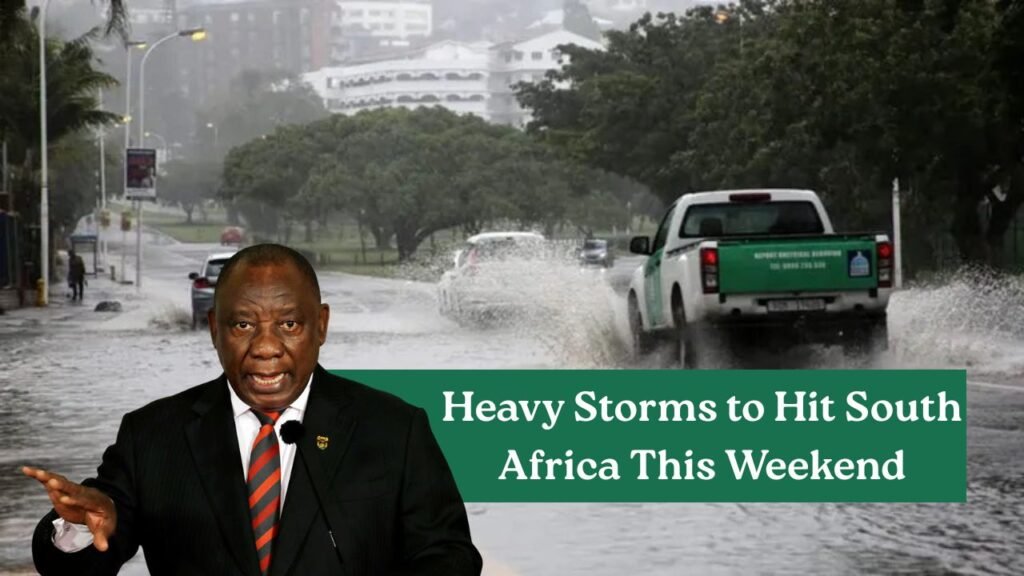South Africa Weather Alert – South Africa is bracing for severe weather conditions as heavy rain and storms are expected to sweep across multiple regions this weekend. The South African Weather Service has issued alerts warning residents about the possibility of flooding, strong winds, and hazardous driving conditions. Communities in low-lying areas are being urged to take extra precautions as flash floods could occur with little warning. Power disruptions and damage to infrastructure may also result from the severe storms. Authorities are encouraging citizens to stay updated on official alerts, avoid unnecessary travel, and prepare emergency supplies in case of extended outages. Farmers and outdoor workers have also been advised to take safety measures, as the storms are predicted to bring widespread disruption. With the weather system expected to intensify over the weekend, it is crucial for residents to remain vigilant and follow safety guidelines provided by local authorities. The upcoming days may prove particularly challenging, and preparedness will be key to minimizing risks.

Expected Impact Across South Africa
The predicted storm system is likely to impact both urban and rural areas, with flooding posing the greatest risk in provinces such as KwaZulu-Natal, Eastern Cape, and parts of Gauteng. Urban centers may face waterlogged roads, traffic delays, and disruptions to public transport, while rural areas are more vulnerable to landslides and river overflows. Authorities have also highlighted the potential for damage to homes with weak roofing and to crops in agricultural regions. Heavy winds could cause fallen trees and power lines, resulting in blackouts in certain communities. Travel along major highways may become dangerous, and motorists are urged to reduce speed and exercise caution. Emergency services are on standby, but citizens are reminded that their cooperation is essential in reducing the strain on responders. By preparing in advance, families can help ensure their safety while minimizing the economic and infrastructural damage the storm may cause.
Safety Measures and Government Response
In anticipation of the storms, government agencies have already begun coordinating emergency responses. Local municipalities are setting up temporary shelters in case evacuations become necessary, particularly in flood-prone regions. The Department of Cooperative Governance and Traditional Affairs has called for community leaders to assist in spreading awareness about the risks. Families are encouraged to secure loose items around their homes, avoid crossing swollen rivers, and keep emergency numbers close at hand. The South African Weather Service continues to monitor the system closely and will provide real-time updates. In addition, disaster management teams have been deployed to high-risk areas, ensuring resources such as food, blankets, and medical supplies are readily available. This proactive approach aims to protect vulnerable communities, reduce casualties, and ensure rapid recovery efforts. As the weekend approaches, the focus remains on safeguarding lives while minimizing the destructive impact of the storm.
Travel Warnings and Transportation Disruptions
Severe weather is expected to cause significant disruptions to travel and transportation across South Africa. Flights at major airports may experience delays or cancellations, while road closures could occur due to flooding and debris. Commuters using public transportation are advised to plan ahead, as rail and bus services might also be impacted. Long-distance travel is strongly discouraged during the storm, particularly through regions with steep terrain or poorly maintained infrastructure. The South African National Roads Agency has already cautioned drivers to stay alert for slippery surfaces, potholes, and fallen objects. Truck drivers and delivery services are being warned of high wind risks, which could topple heavy vehicles or lead to accidents. Residents planning holiday trips are advised to postpone their journeys until the weather stabilizes. Staying indoors and limiting travel will be one of the most effective ways to remain safe throughout this period of severe storms.
Community Preparedness and Individual Responsibility
Beyond government efforts, individual and community preparedness will play a crucial role in managing the storm’s impact. Households should ensure they have stocked up on essentials such as drinking water, non-perishable food, flashlights, and batteries in case of prolonged power cuts. Parents are advised to keep children indoors and away from flooded areas, while pet owners should make arrangements to shelter animals safely. Community groups can organize support systems to check on elderly or disabled neighbors who may need assistance during the storm. In areas with a history of flooding, residents are advised to keep sandbags ready and to move valuables to higher ground. While natural disasters cannot be prevented, early preparation can significantly reduce harm and inconvenience. By working together, citizens can not only protect their families but also strengthen resilience across neighborhoods. The storm serves as a reminder of the importance of preparedness and collective responsibility in times of crisis.



